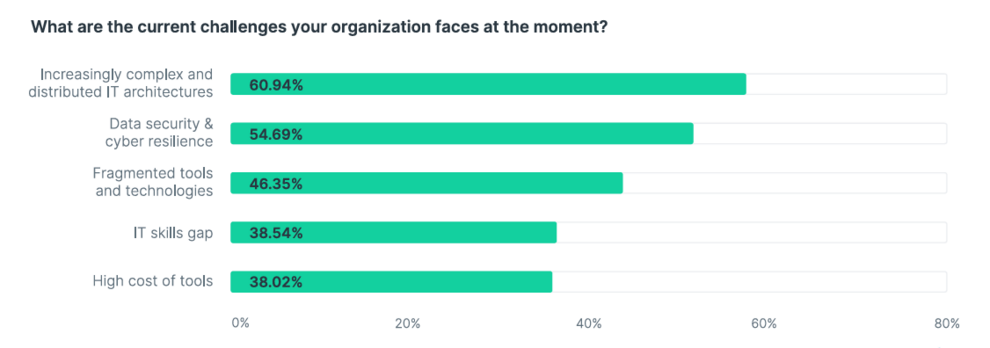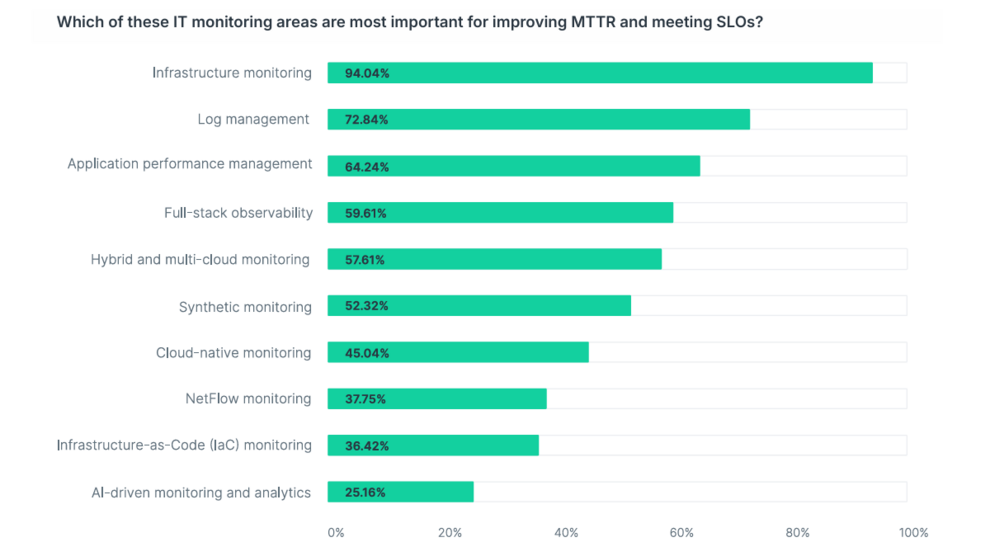Technologies like cloud computing, containerization, and serverless computing have revolutionized IT infrastructure, but they are also presenting IT teams with increasing challenges. Our “Rising to the challenge” survey, conducted with nearly 200 IT professionals worldwide, highlights how teams are grappling with growing complexity, the trends shaping the industry, and the strategies that can help them navigate the digital transformation successfully. In this post, we share the key insights.
Growing complexity undermines control and security
For most organizations, expanding the scalability and flexibility of IT infrastructure remains a top priority. However, this unrelenting dynamism comes at a cost: 80% of the IT professionals surveyed are grappling with increasingly complex tasks, and 83% feel heightened pressure to keep up with the rapid pace of innovation. Furthermore, nearly two-thirds of respondents express concern over the growing complexity of modern IT environments, as it makes management more difficult, expands the attack surface for cyber threats, and jeopardizes efficient IT operations.
Fragmented tools and technologies, along with a lack of skilled personnel, further compound these issues. Many teams lack the resources to develop coherent strategies for their tool ecosystems. Instead, they resort to quick fixes to address immediate needs, often opting for isolated solutions that further escalate costs, complexity, and maintenance burdens. Alarmingly, 59% of respondents report that these short-term measures frequently backfire, leading to new challenges later on.
Heavy workloads, IT skills gaps, and limited help from AI
Nearly half of the respondents report that staffing shortages are leading to significant additional workload. Only 40% of those surveyed expect AI to provide substantial relief in their daily tasks.
Rising IT complexity is exacerbated by a persistent shortage of skilled professionals. Nearly half of the participants noted that IT skills gaps lead to significant increases in workloads. Even more concerning is that nearly 50% of respondents identified a lack of skills and knowledge as a primary obstacle to IT modernization – a 10-percentage-point increase in just two years.
The technological shift is reshaping roles and job requirements. Continuous learning is critical, and the pressure to upskill remains high. Over the past year, IT professionals have gained new skills, with automation, configuration management, and IT monitoring staying at the top of in-demand qualifications. Programming and DevOps skills are also rising, reflecting the industry’s move toward shorter deployment cycles and agile workflows.
Spotlight on sustainability and efficiency
A remarkable 94% of IT professionals anticipate acquiring new skills in the coming year, with many focusing on technologies that enhance the efficiency and oversight of modern IT infrastructures. Hybrid and multi-cloud management, along with container orchestration, are considered essential by two-thirds of respondents for improving operational efficiency and optimizing resource use.
Sustainability is another growing concern. For half of our respondents, building more energy-efficient data centers has become a critical objective, making it one of the fastest-growing priorities within IT teams.
Monitoring as a pillar of IT operations
As modern IT stacks become more complex and prone to failures, an overwhelming majority of respondents (94%) consider IT infrastructure monitoring essential to reducing Mean Time to Resolution (MTTR) and ensuring agreed-upon service level objectives (SLOs). Log management follows at 72%, with application performance management at 64% and full-stack observability at 60%, as IT teams increasingly rely on tools and methods that provide deeper insights into system components and dependencies, aiming for end-to-end visibility. AI-driven monitoring remains at the bottom – for now.
A noteworthy challenge in improving MTTR: more than half of IT professionals see a lack of skills as the second-biggest obstacle – right after the growing complexity of modern IT infrastructures.
Conclusion
The results of our survey paint a clear picture: IT teams are walking a tightrope between innovation, resource constraints, and growing demands. With existing resources stretched thin, achieving digital transformation is an uphill battle. The need for support is clear – whether through targeted training programs, collaboration with managed service providers, or SaaS tools. Without these, the path to mastering digital transformation becomes far steeper.
Want to learn more about the challenges IT teams face and the strategies to overcome them? Download our whitepaper for in-depth insights.



